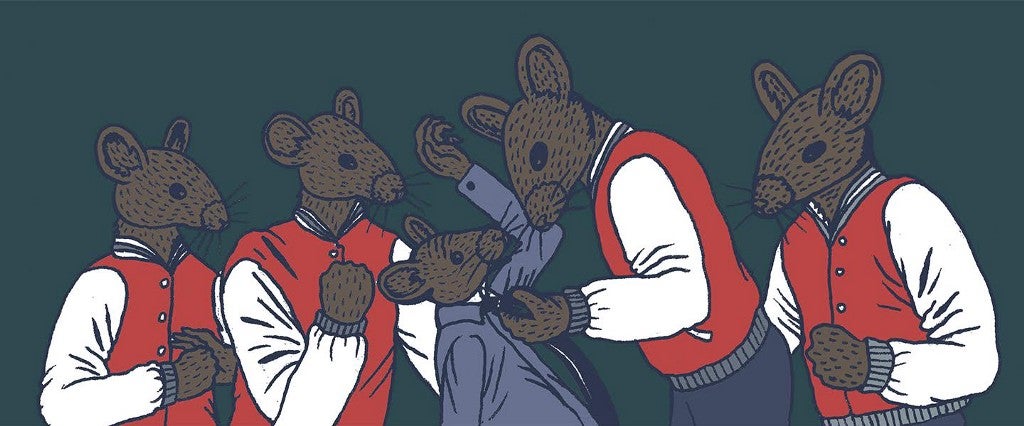A bully never explains why he’s into bullying. Like racists, or Trump voters, bullies are discussed, feared, analyzed, denounced—but to be a bully is to defy argumentation, to deny your very bullydom, to insist that you’re just a patriot, a comedian, a defender of the faith. “Why are you hitting me?” we ask, hoping we might be able to convince them to stop. “Why are you hitting yourself?” they reply.
Because bullying doesn’t make sense. Bullying just feels good. Or, to paraphrase the closest thing they’ve got to a spokesbully: Bullying feels terrific.
Or at least it does in mice. A new study out of the Icahn School of Medicine at Mount Sinai found that bullying is pleasurable and pinpointed the pathway followed by the neural rewards of bullying in the brain. The experiment used aggressive male mice as stand-ins for aggressive male humans, but it looked at a part of the brain that mice and men have in common, meaning there’s a good chance that the same pleasurable mechanisms are at work in the brains of certified human jerks around the world.

“Aggression is one of the most conserved cognitive functions we have,” says Sam Golden, the lead author on the paper and a postdoctoral fellow at the National Institutes of Health. “Few fundamental driving motivators are as effective, so you don’t have to look far to find it to be reinforcing.”
How did these neuroscientists even find these tiny Nelsons Muntz? And what does it mean to be a bully, as a mouse? Most importantly: Can they be stopped?
Golden led me through the basics. To create a good environment for bullying, the researchers put puny, virgin male mice into the cages of bigger, sexually experienced males. Upon finding a weaker rival nearby, two-thirds of the big mice went over and started biting the little dudes on their haunches—the mousey equivalent of a shove into the lockers, a series of purple nurples, or flooding your DMs with death threats.
Soon, the two-thirds of the big mice that had a taste for low-grade violence started hanging around the area of their cages where researchers were depositing the victim mice, hoping to find a one-sided fight. They were hooked.
Then the researchers killed the bullies and chopped up their brains. They injected a fluorescent virus into the part of the brain they suspected had something to do with the pleasurable sensation of violence, the basal forebrain. From there, the virus spread along the pathways connected to that node, creating an illuminated roadmap as it went. They were then able to narrow down which pathway was most active during the pleasurable bullying experience by tracking the concentration of a protein called c-Fos, which lingers for a specific length of time in the wake of neural activity, like contrails behind a jet.
But brains are complicated. To make sure that this c-Fos trail wasn’t just neural noise, the researchers then took some live mice and drilled lasers into their skulls. Using the genetic tweaking method known as optogenetics, they attached an on-off switch to the parts of the brain the c-Fos had shown was probably responsible for the pleasure of aggression. Laser goes on, circuit goes off.
And it worked.
With their brain lasers inhibiting the action along that pathway, the bullies lost interest in messing with their puny colleagues. Short of embedding a chip in budding bullies’ skulls, though, what does this mean for us humans?
“Our real hope is that, by understanding the basic neurocircuitry of aggression,” Golden says, “we might be able to treat depression.”
Aggression isn’t always considered to be one of the symptoms of depression, but Golden thinks they’re more deeply related than the prevailing definitions lead us to believe. “If you use maladaptive or inappropriate aggression as a criterion,” Golden says, “the incidence of depression in men is equal to that of women. It’s not far-fetched to say that men might try to deal with depression by going to the bar, having a few drinks, and lashing out.” The rush of bullying, like the rush of a stiff drink or a fistful of Doritos, can give the depressed mind a little taste of the pleasure it’s lacking.
And on a practical level, Golden has experience observing the ways bullying and depression overlap. His prior research on the depression in the demoralized brains of bullied mice, rather than the bully mice, led him to this most recent project. One of the only surefire ways to make a mouse exhibit human-like depression is to bully it, mercilessly, in order to induce “chronic social defeat stress.” If the psychological pain of being on the receiving end of aggression can lead to mousey melancholy, and that pain follows similar neural pathways as the pleasure of dishing the aggression out, figuring out the locus of the aggression-pleasure circuit might ultimately reveal new therapies for both unchecked rage and ongoing emotional pain.
In the short term, knowing the precise mechanism for how aggression makes you feel good means that doctors trying to treat people with aggression problems (like intermittent explosive disorder, which is exactly what it sounds like) or severe depression can try zeroing in on the brain regions involved with something like deep brain stimulation, where a little brain pacemaker is hooked up to a particular neural area. In the long term, this might mean that researchers can develop pharmaceuticals capable of regulating the specific neurotransmitters and pathways involved in bully pleasure.
For the moment, this research confirms what the chronically socially defeated pipsqueaks of the world have always known: Bullies just get a kick out of seeing you squirm.
